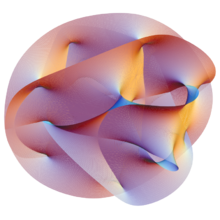- String (physics)
-
This article deals with string as an object of string theory. For a usual string such as a guitar string, see vibrating string.
String theory 
Superstring theory ConceptsRelated TopicsA string is a hypothetical vibrating one-dimensional sub-atomic structure and one of the main objects of study in string theory, a branch of theoretical physics. There are different string theories, many of which are unified by M-theory. A string is an object with a one-dimensional spatial extent, unlike an elementary particle which is zero-dimensional, or point-like. Quarks and electrons are thought to be made of string.
By postulating this one-dimensional structure, many desirable features of a more fundamental theory of physics automatically emerge. Most notably, almost any theory of strings consistent with quantum mechanics must also contain quantum gravity, which had not been described consistently prior to string theory.
The characteristic length scale of strings is thought to be on the order of the Planck length, the scale at which the effects of quantum gravity are believed to become significant:
 m
m
On much larger length scales, such as the scales visible in physics laboratories, such objects would be indistinguishable from zero-dimensional point particles. However, the vibrational modes and structure of the tiny string would be manifested as different elementary particles in the standard model of quantum field theory. For example, one state of the string would be associated with a photon, and another state with a quark. This unifying feature of string theory is among its greatest strengths, however no known solution of string theory exactly reproduces the particle content of the standard model.
Propagating in spacetime, strings sweep out a two-dimensional surface, called a worldsheet, analogous to the one-dimensional worldline traced out by a point particle.
Contents
Types of strings
Closed and open strings
Strings can be either open or closed. A closed string is a string that has no end-points, and therefore is topologically equivalent to a circle. An open string, on the other hand, has two end-points and is topologically equivalent to a line interval. Not all string theories contain open strings, but every theory must contain closed strings, as interactions between open strings can always result in closed strings.
The oldest superstring theory containing open strings was type I string theory. However, the developments in string theory in the 1990s have shown that the open strings should always be thought of as ending on a new type of objects called D-branes, and the spectrum of possibilities for open strings has increased greatly.
Open and closed strings are generally associated with characteristic vibrational modes. One of the vibration modes of a closed string can be identified as the graviton. In certain string theories the lowest-energy vibration of an open string is a tachyon and can undergo tachyon condensation. Other vibrational modes of open strings exhibit the properties of photons and gluons.
Orientation
Strings can also possess an orientation, which can be thought of as an internal "arrow" which distinguishes the string from one with the opposite orientation. By contrast, an unoriented string is one with no such arrow on it.
See also
- Brane
- Elementary particle
- List of string theory topics
- The Elegant Universe and The Fabric of the Cosmos, two books by string theorist Brian Greene
References
- Schwarz, John (2000). "Introduction to Superstring Theory". Retrieved Dec. 12, 2005.
- "NOVA's strings homepage"
Categories:
Wikimedia Foundation. 2010.
